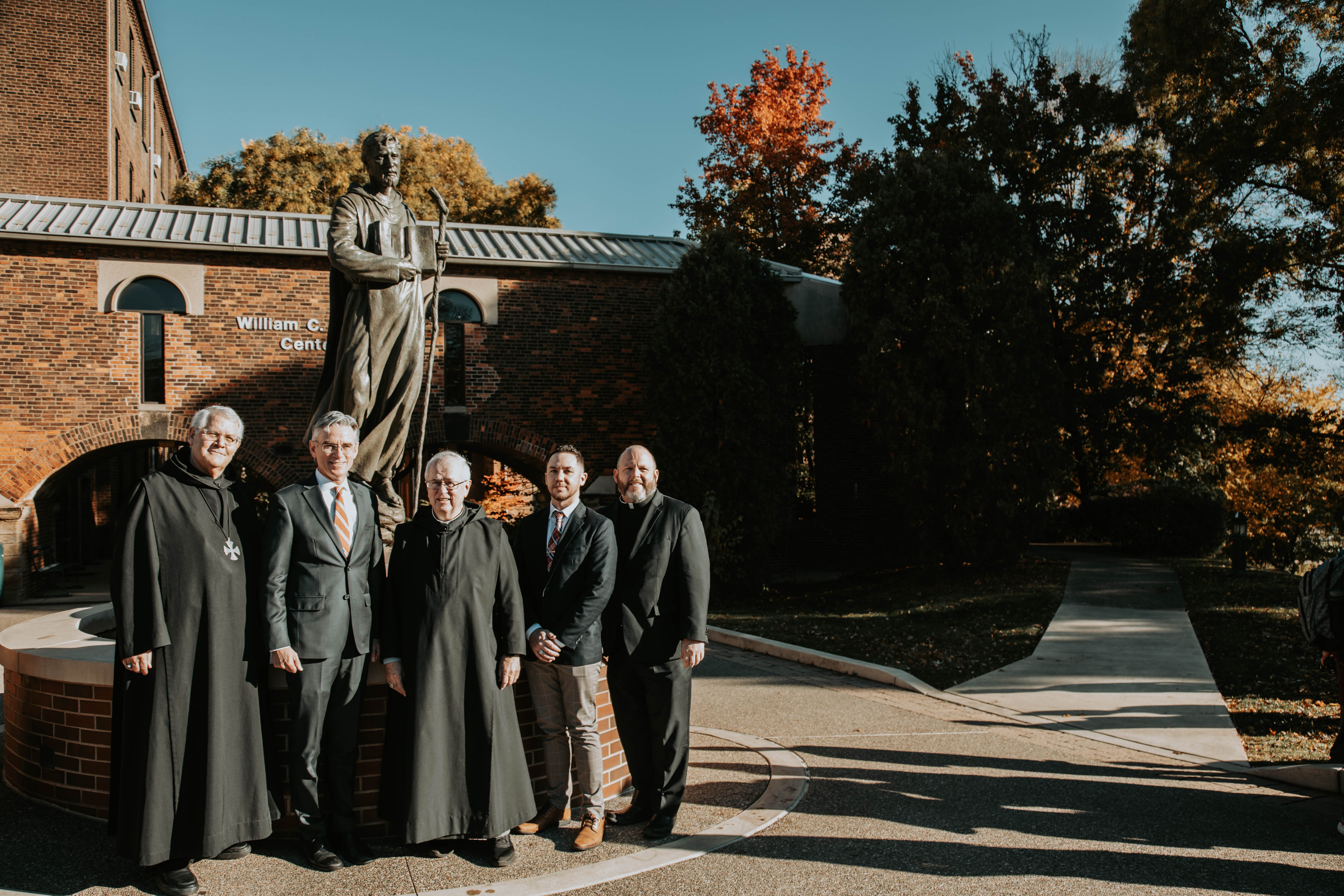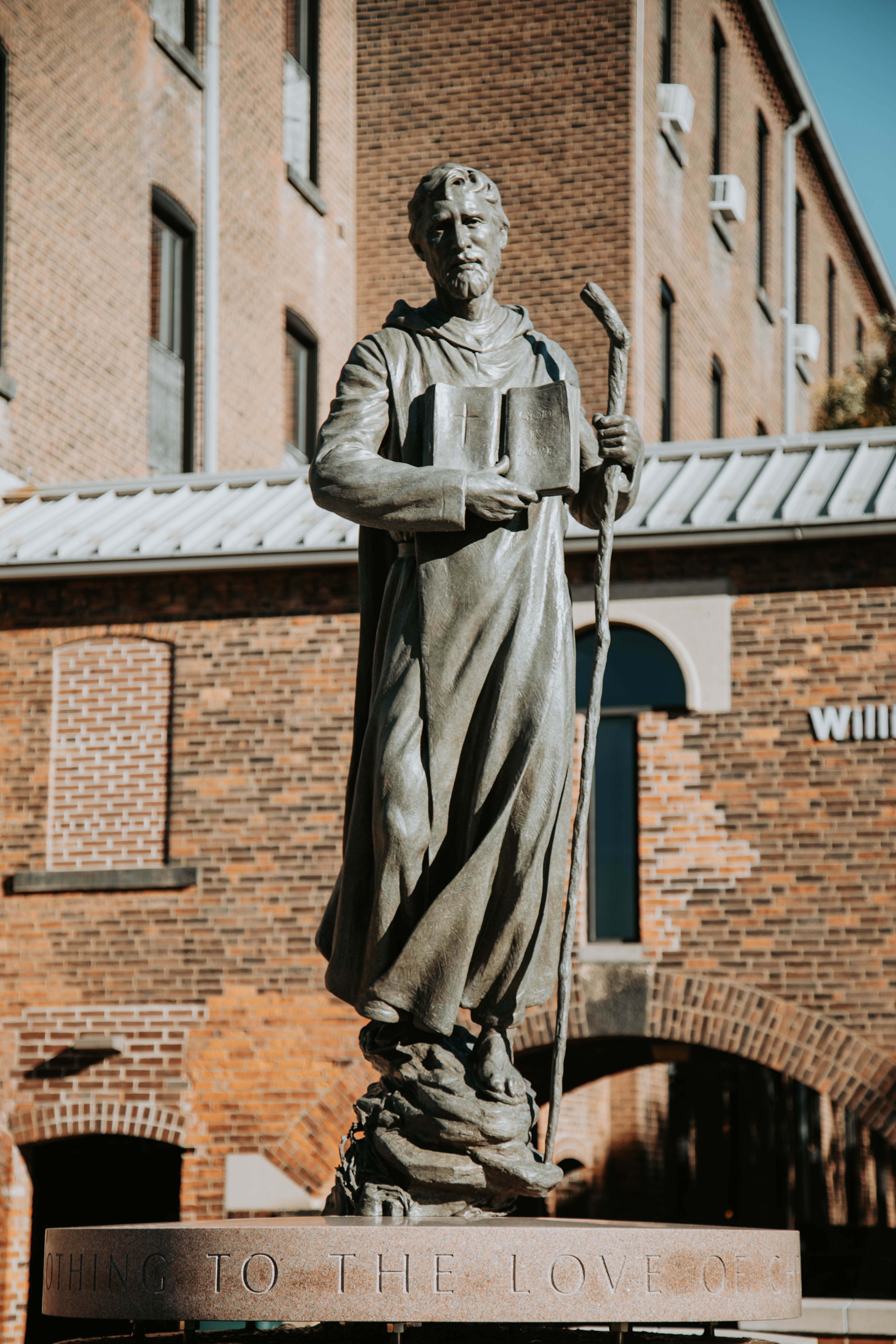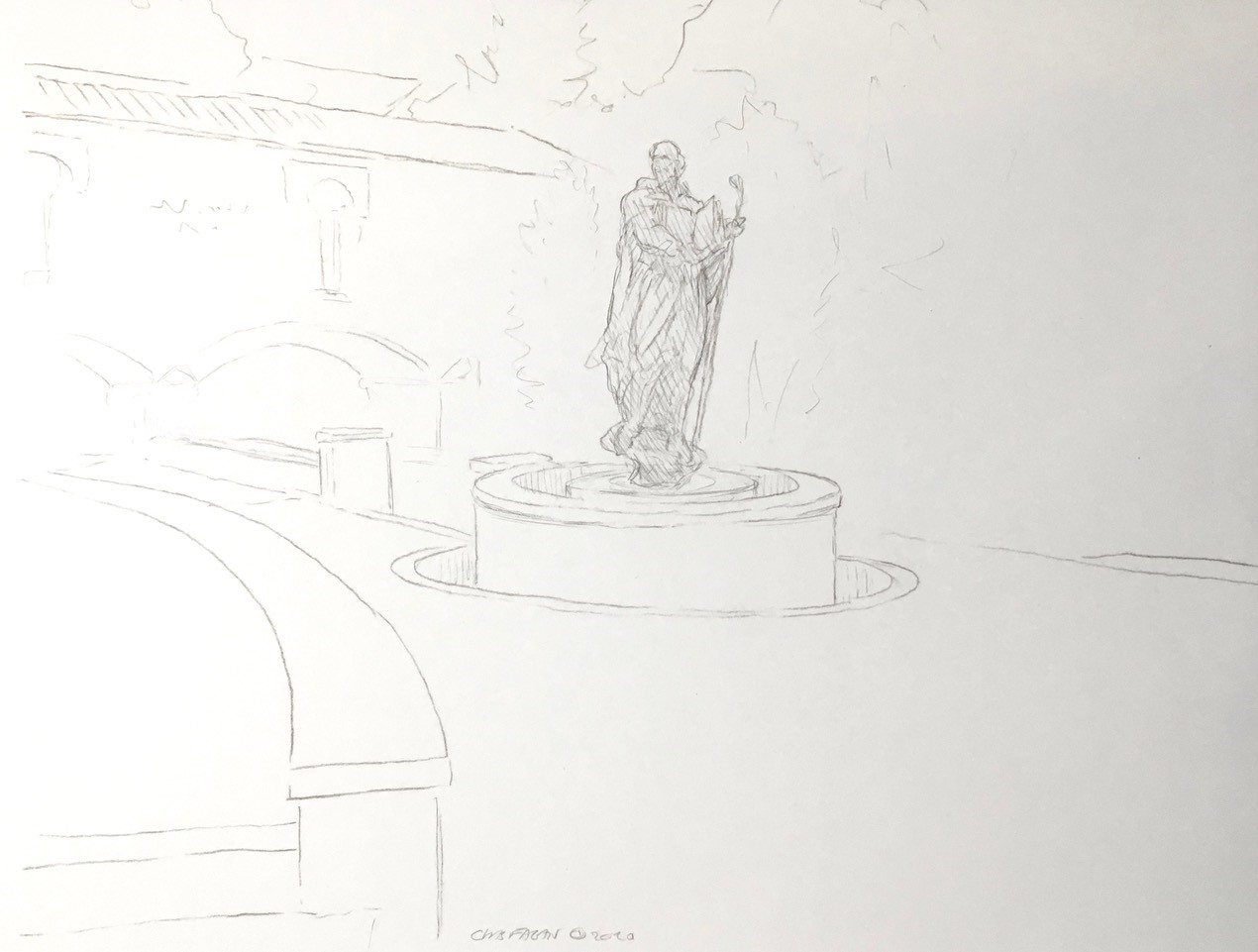SVC installs statue, holds dedication and blessing ceremony
SVC installs statue, holds dedication and blessing ceremony
-
In This Section
- Saint Vincent College Fall 2021 Dean's List
- Saint Vincent College Chapter of Society of Catholic Scientists to host Gold Mass
- McKenna School to host lecture on Lincoln's humor
- SVC Community to Celebrate 'Life in Christ Week'
- SVC student to intern with Lincoln Highway Experience
- Verostko Center for the Arts to Open Two New Exhibits
- SVC Management: Operational Excellence Ranked Top Tier of Online Master's in Business Programs
- SVC Center for Political and Economic Thought to host Dr. Shawn Ritenour
- Center for Political and Economic Thought to host Professor Christopher Wolfe
- Saint Vincent College School of Arts, Humanities and Social Sciences receives grant from PA Humanities
- SVC Players to present "All Shook Up" Feb. 17-20
- Saint Vincent College Announces Plans to Build New Athletic and Recreation Center
- Saint Vincent College Announces Winners of Wimmer Scholarship Competition
- Fred Rogers Center to Launch 'Won't You Be My Neighbor, Again?' Series with Latrobe Art Center
- Pittsburgh Symphony Orchestra to return to Saint Vincent Basilica
- Saint Vincent College Small Business Development Center to host Business Seminar
- Annual Pasta Bridge Competition Scheduled for March 7
- SVC Challenge Camp Registration Now Open
- Saint Vincent College Student Places Third in Women's USA Weightlifting 2022 National University Championships
- Music at Midday Series to continue with Dr. Sean Durkin and Christopher Pardini
- Saint Vincent College Small Business Development Center to host Search Engine Optimization Webinar
- Center for Political and Economic Thought to host Economist on Health in Appalachia
- Students Inducted into Alpha Lambda Delta Honor Society
- Saint Vincent College announces John T. Delaney as new Vice President for Academic Affairs
- Saint Vincent College Education Department Organizes Humanitarian Effort to Help Ukrainian Refugees
- SVC Concert Series to Continue With Rivera and Carver
- Verostko Center for the Arts to Host Senior Exhibition
- Boyer School Forward Series to Continue on March 31
- Saint Vincent College Singers to Perform Piece by CMU Professor in Archabbey Basilica
- Author Zena Hitz to Deliver Keynote Address During Philosophy Department Spring Colloquium
- Saint Vincent College Announces Peter Stephans as Spring 2022 Commencement Speaker
- Saint Vincent College Chapter of Society of Catholic Scientists to Host Dr. Chris Stoughton
- 2022 Spring Celebration of the Arts to Conclude with Music at Midday and Poetry Reading
- Students Inducted into Lambda Pi Eta Communication Honor Society
- Students Present at ECA Conference
- Saint Vincent College Announces Policy, Structural Changes to Ensure Benedictine Principles Upheld
- An Update for Our Community
- SVC to Host 19th Annual Academic Conference
- 2022 Spring Honors Convocation
- Saint Vincent College, Fred Rogers Center to Launch Second Installment of "Won't You Be My Neighbor, Again?" Series
- Amanda Cecconi, C'87, Delivers Honors Convocation Address
- Dr. Michelle Duennes Receives Quentin Schaut Faculty Award
- Dr. Jeffrey Godwin Receives Boniface Wimmer Faculty Award
- Sydney R. Green Named 2022 President's Award Winner
- Students, Faculty Recognized at Spring Honors Convocation
- Students Inducted Into Pi Mu Epsilon Mathematics Honor Society
- Saint Vincent College Professors Publish Book on Mister Rogers
- Three Hundred Ten Degrees Awarded at Spring Commencement
- SVC Education Department, Equestrian Program Host Presentation on Equine Assisted Psychotherapy
- 176th Spring Commencement Address
- Saint Vincent Summer Theatre to Return with Two Shows
- Alpha Lambda Delta Chapter at Saint Vincent College Wins National Chapter Award
- 2022 Challenge Program Registration Closes May 31, 2022
- How to be a more active student without losing your mind
- 176th Spring Commencement Platform Participants
- Saint Vincent College announces 2022 Athletic Hall of Fame class, recognizes 2020 and 2021 inductees
- Saint Vincent Pair Honored at PAC Scholar-Athlete of the Year Banquet
- SVC Student-Athlete Awards Announced
- Fred Rogers Center for Early Learning and Children's Media Becomes Fred Rogers Institute
- Winnie Palmer Nature Reserve at Saint Vincent College to Host Talk and Opening Reception
- Pittsburgh Steelers Training Camp Open Interviews Planned for June 1st and 2nd
- Verostko Center for the Arts to Open New Summer Exhibit
- Saint Vincent College Announces Michael J. Urick as New Dean of Alex G. McKenna School of Business, Economics and Government
- Boyer School Students to Attend Graduate and Ph.D. Programs
- Boyer School Graduates to Attend Medical and Professional Schools
- Boyer School Students Accepted into Allied Health Programs
- Saint Vincent Professor to Screen Films as Part of Pittsburgh Film Kitchen Series
- Saint Vincent Summer Theatre Returns Tuesday with 'Nunsense'
- AHSS Graduates to Attend Graduate School
- Fred Rogers Institute to host Virtual Educators' Symposium
- Spring 2022 Dean's List
- Dr. Stephen Jodis Awarded Education Leadership Award for Post-Secondary Education
- Bat Box Installed in Partnership with CNX Resources and PA Game Commission
- Saint Vincent College Students Take on Training Camp
- Verostko Center for the Arts to host Ukrainian icon exhibit
- U.S. News & World Report ranks Saint Vincent College as a top tier national liberal arts college for 13th consecutive year
- Albert J. Novak Jr. returns to Saint Vincent College as VP for Philanthropy & Alumni Relations
- Saint Vincent College announces 2022 Alumni of Distinction
- SVC's McKenna School restructured into three departments
- Dr. Thomas Octave welcomed as a member of the inaugural Mathis Liturgical Leadership cohort of Notre Dame
- SVC Helpful Tips From Some Fellow Students
- Music at Midday Series returns to Saint Vincent College campus
- SVC student secures two awards for research project, selected as finalist for annual International Atlantic Economic Society Best Undergraduate Paper Competition
- Saint Vincent College breaks ground on Dunlap Family Athletic and Recreation Center
- Saint Vincent College hosts annual Homecoming Weekend, announces Homecoming Queen and King
- SVC’s Community Meal Program to return
- Saint Vincent College, Verostko Center to celebrate Oktoberfest
- Saint Vincent College professor does reading, presents at conference
- Fred Rogers Institute, SVC, welcome first Fellow in Mental Health and Wellbeing
- SVC professor selected as finalist for graphic literature award
- Kimberly M. Colonna, Esq., C’94, next speaker in Manoli Lecture Series
- SVC student spends summer months with Benedictine Nuns
- SVC Players to present ‘Little Women’ Oct. 28-30
- Saint Vincent College Education Department to host Schooling Your Way conference
- Saint Vincent College, Excela Health to host Faces of Battle lecture and discussion
- Three Saint Vincent College alums publish books
- SVC physics professor publishes article in “The Physics Teacher” journal
- SVC installs statue, holds dedication and blessing ceremony
- SVC concert series returns with Cornetti and Lemberskaya
- SVC to host Montserrat Boys Choir
- Foster and Muriel Coverlet Gallery, Verostko Center to debut new exhibits
- SVC chemistry professor publishes article in “C&EN News” magazine
- SVC’s Music at Midday series to continue with band Phineas Gage
- Saint Vincent's Irefin Named PAC Special Teams Player of the Week
- Saint Vincent College Selected for 2022 ECAC Division III Volleyball Tournament
- Fred Rogers Institute to host second annual Kindness Campaign
- Boyer students participate in summer internship panel
- Saint Vincent College will celebrate Founders’ Day on Thursday, Nov. 17, 2022
- Eulalia Books to host poetry reading in anticipation of upcoming release
- SVC Mock Trial team places first at St. Bonaventure tournament
- SVC hosts annual Winter Honors Convocation, Founders’ Day
- Three students place second at ASCM Case Competition
- SVC’s Music at Midday series to continue with mother-daughter flute and piano duo
- Saint Vincent College welcomed three Assistant Vice Presidents
- Saint Vincent College to hold 18th annual December Commencement Ceremony
- Dr. Amanda Draper Selected for the Gretsch Fellowship in Children’s Music at the Fred Rogers Institute
- SVC Wraps for Kids returns after two-year hiatus
- Dr. Tracy McNelly receives Thoburn Excellence in Teaching Award
- Center for Catholic Thought and Culture presented with 2022 Projektenmacher Award
- Saint Vincent College awards degrees at 2022 December Commencement
- News 2022
LATROBE, PA—On Thursday, Oct. 27, Saint Vincent College held a blessing and dedication ceremony for a new statue, which was placed outside the campus post office, in the middle of the College’s campus.
Rev. Douglas Nowicki, O.S.B., Archabbot Emeritus, initiated the project during his tenure as archabbot. Funded in part by anonymous donors, the bronze statue of St. Benedict was created by American artist Chas Fagan.

St. Benedict of Nursia (ca. 480 – 547 CE) was a Christian monk, writer, and theologian, most known for authoring “The Rule of St. Benedict,” a text that formalized the structure of life among men and women’s monastic communities throughout Western world. Because of this, St. Benedict is widely regarded as the founder of Western Christian monasticism. He is also the Patron Saint of Students.
When Boniface Wimmer, O.S.B., arrived in America in 1846, he founded Saint Vincent College, the first Benedictine monastery in the United States and largest in the Western Hemisphere. As a landmark Benedictine institution, Saint Vincent has woven the values presented in “The Rule of St. Benedict” into its liberal arts curricula and campus life to continue the tradition of Benedictine education, which is guided by the 10 Hallmarks presented in “The Rule”: love, prayer, stability, obedience, discipline, humility, stewardship, hospitality and community.
Saint Vincent College President Father Paul Taylor, O.S.B., gave remarks to open the ceremony, expressing gratitude to those who made the project possible.
“We’re grateful to all the donors who made this possible. Thank you for your generosity, your investment and your confidence in us to make this happen,” Father Paul said. He continued, “We are also grateful for the vision of Archabbot Emeritus Douglas Nowicki, who saw this project as another articulation of our mission.”
He went on to add, “We will look as a community upon this statue each day as a reminder of our mission and the vision that St. Benedict gives us in his rule for the care for one another as we all seek God together.”
Andrew Julo, Director of the Roman Verostko Center for the Arts, followed Father Paul, introducing Fagan. “At the core of Fagan’s work lies a commitment to honoring individuals within our collective history whose actions and ideas have helped shape the aspirations of millions around the world through the long arc of time,” noted Julo. “[His projects] remind us that holiness is not limited to a distant past but is made manifest within the lives of ordinary people committed to extraordinary love.”
Following Julo’s introduction, Fagan discussed his process and his artistic choices. “This was a truly fun and fantastic project. It also got me to come back home, which is great,” said Fagan, who has roots in Ligonier.

Traditionally, St. Benedict is depicted as an older man, but Fagan and Nowicki decided that a much more meaningful approach would be to portray St. Benedict as youthful, engaged and energetic. After researching St. Benedict and reading “The Rule,” Fagan drew inspiration from several passages in “The Rule” that centered around the idea of movement.
“He’s a man of motion,” explained Fagan. “The idea of movement, for me, means moving forward, always learning. You’ve always got something around the corner. It’s the kind of thing that really inspires me.”
With the idea of youthfulness and motion in mind, Fagan created a St. Benedict who is seen as striding forward over a terrain covered in thorns and uneven rocks, his robes being slightly lifted by a gentle wind. He’s holding a book, which onlookers will notice is “The Rule of St. Benedict,” and he’s carrying a shepherd staff to symbolize guidance and protection.
The statue sits on a base within a fountain. The base, a gift from the Class of 1968, is inscribed with the phrase “Prefer nothing to the love of Christ.” In order to read the inscription, however, viewers must circle around the entirety of the fountain, adding their movement to the action Fagan has created in the statue.
“The legacy of St. Benedict is all around us,” Fagan remarked. “He’s now standing in the middle of his community today. So here he is, personally encouraging the next generations for the future, guiding them toward a Christ-inspired life of selflessness, a life of learning and a life of work, all of which offer the greatest rewards and joy.”
Following Fagan’s remarks, Archabbot Martin de Porres Bartel, O.S.B., blessed the statue and led those present in a short prayer.
ABOUT THE ARTIST

American artist Chas Fagan grew up in Belgium and in rural Pennsylvania, gathering inspiration from the rich landscape and history of his surroundings.
Fagan’s ability to combine his artistic gifts with his knowledge of history has led to several high-profile commissions. Among his favorites are his statue of President Reagan in the Rotunda of the U.S. Capitol, a “young Neil Armstrong” statue for Purdue University (including a surrounding plaza with moon-boot prints), his sculpture of Rosa Parks in the Narthex of Washington National Cathedral and a monumental-scale bronze sculpture in Dallas titled “Freedom’s Charge” that features two Revolutionary War figures and a billowing battalion flag from Bunker Hill. He was also fortunate to be asked to paint the official White House portrait of First Lady Barbara Bush and the official portrait of Mother Teresa for her canonization at St. Peter’s in Rome.
A self-taught artist, Fagan graduated from Yale University with a degree in Soviet Studies.
